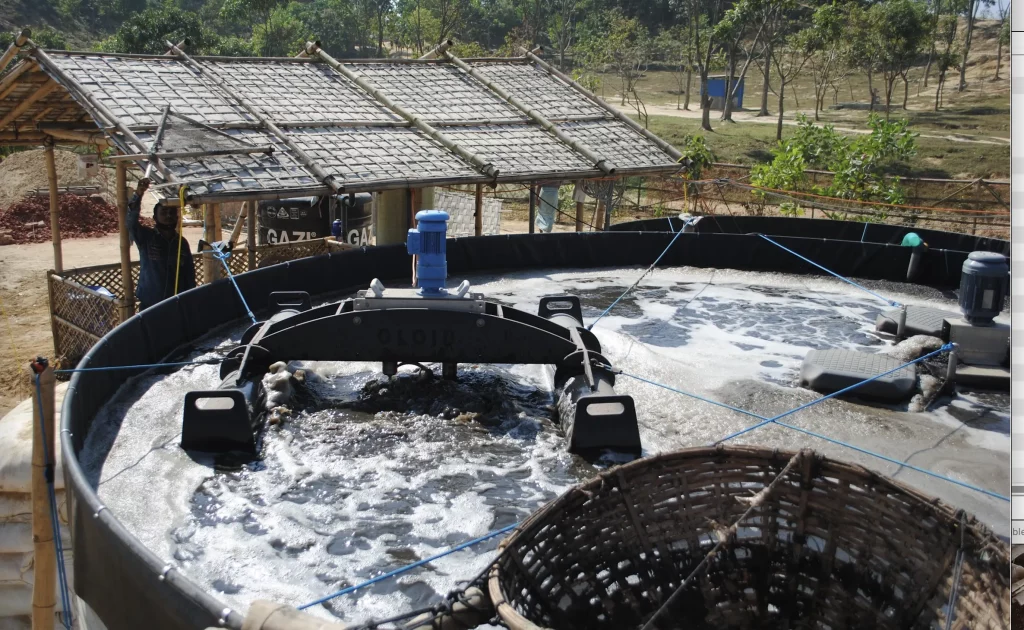2.2 Stabilisation
Stabilisation is a process that helps to make faecal sludge more stable by breaking down organic molecules. This process reduces the sludge’s oxygen demand, making it more stable and less biologically reactive. Stabilisation occurs when the easy-to-degrade molecules are decomposed, reducing the oxygen demand.
Apart from making the faecal sludge more stable, meaning it is less odorous, less likely to cause pollution, and more amenable to subsequent handling or disposal, stabilisation offers other benefits, such as preventing the sludge from foaming, which improves the dewatering properties.
Depending on the time spent in onsite confinement, the level of stabilisation of faecal sludge may differ. Additional stabilisation can be accomplished either aerobically, anaerobically or chemically.
Aerobic Stabilisation
Aerobic stabilisation is a process that involves supplying oxygen to sludge in an aeration tank and will be further introduced in the respective lesson.

However, if done as a part of composting, an aerobic process that decomposes organic wastes and produces compost, the treatment of organic wastes would require less energy because it relies on natural microorganisms and does not need external heat or chemicals. Compost contains nutrients and organic carbon that improve soil quality. This method will be introduced in lesson 4 (Co-composting). Other methods covered in this training are vermicomposting, black soldier fly larvae treatment, and composting methods that use worms, fungi, and insects to break down organic wastes.
Anaerobic Stabilisation
Sludge can be stabilised using an anaerobic digester without additional energy. This method is more stable because the microbial communities can endure greater changes in environmental conditions and use less energy. Please visit the training on Biogas Sanitation that introduces anaerobic digestion and biogas recovery.

Chemical Stabilisation
Chemical stabilisation is a method of stabilising faecal sludge with the help of chemicals.
Quicklime (CaO) or hydrated lime (Ca(OH)2) are common additives that react with the sludge and increase the pH, creating an alkaline environment. This alkalinity contributes to pathogen reduction and the control of odours.

To achieve effective stabilisation, the lime should be thoroughly mixed with the sludge. To sanitise the sludge, the pH should be maintained above 12 for at least two hours. Lime-stabilised biosolids can enhance acidic soils, improving soil pH and structure. However, the addition of lime-stabilised sludge to alkaline soils is unsuitable, as it may cause nutrient imbalances or toxicity. Lime stabilisation also reduces the nitrogen content of the biosolids, as some nitrogen is lost as ammonia gas during the process. Therefore, lime-stabilized biosolids may need to be supplemented with other nitrogen sources prior to their addition to the soil to ensure optimal crop growth.
Lime stabilisation can completely inactivate E. coli and Salmonella if appropriately done in a short period showcasing its potential to enhance the hygienic aspect of sludge management. However, the inactivation of helminths is more challenging. Lime has been reported to have inactivation efficiencies between 92 and 95% for helminth eggs, but only if the pH of the sludge is maintained above 12 for at least 2 hours and the temperature is above 20°C. The lime dose should be sufficient to achieve a calcium concentration of at least 1% in the sludge.
The recommended lime dosage to achieve a pH above 12 for faecal sludge is between 10-17 kg of lime for each tone of FS, with a recommended contact time of at least 2 hours.
The following table shows an example of a biosolid characteristic from a lime stabilisation plant in the Rohingya refugee camp in Cox’s Bazar.
| TS% | Faecal Coliform | Helminths eggs/g* | ||
|---|---|---|---|---|
| Hydrated Lime Treatment and Drying Beds | Drying bed 1 day | 15 | Nil | na |
| Drying bed 3 days | 32 | Nil | 1 | |
| Final sludge cake | 42 | Nil | 1.5 |
*The viability of eggs was not accessed
It is important to note that quicklime can be hazardous and should be handled with care, as it can cause burns, eye damage, or respiratory problems. Hydrated lime is typically used for lime-stabilization initiatives in refugee camp contexts, as it is safer and more readily available.
